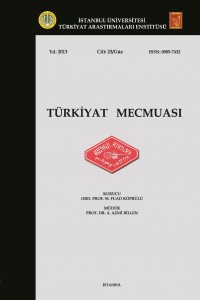Abstract
The issue of educating the age groups which are out of formal school education system is crucially important for the society. From the past many sort of methods have been practiced in order to solve this issue. An example for recent methods can be given as the use of mass media in both visionary and auditory via papers magazines TV and radios. In the beginning of the Islamic societies, narrators educated people with oral stories. Sophisticated stories had been told in order to present exemplary lessons to the people in public places such as coffee houses, village meeting rooms or in the houses of noble people. The epics Ali (fourth Caliph of Islam) , stories of Hamza (Hamzaname) and Battalname are some samples of those oral stories. In takkes and dergahs, however, texts hard-to-understand such as Mantıku’t-tayr of Fariddüdin Attar and the magnifigent Mesnevi of Mevlana had been recited and annotated. In addition to these works, Baydaba’s masterpiece Kalila and Dimna was an important narrative used for education of masses. We chose this Indian-origin work as a subject matter in our study, because it was a common work used in the education of the masses in both Iranian and Turkish literatures. We aim to introduce the translations of Kalila and Dimna which are present in various libraries of Turkey, and also to focus on the contribution of this work to the education of masses.
References
- Ahmed Midhat, 1304 (1888), Hulâsa-i Hümâyunnâme, Matbaa-i Âmire, İstanbul, 600 s.
- BAKAN, Semra, 2006, Kelile ve Dimne’de Yer Alan Masalların Dinî ve Ahlâkî Eğitime Katkıları, Atatürk Üniversitesi, (Basılmamış Yüksek Lisans Tezi), Erzurum.
- Beydaba, http://tr.wikipedia.org/wiki/Beydeba BEYDEBÂ, 1998, Kelile ve Dimne (Hazırlayan: Selâhaddin Alpay- Önsöz ve Takrîzler: Ali Nihad Tarlan, Ahmet Kabaklı, Mustafa Yazgan), Bedir Yayınları, İstanbul.
- CAMPBELL, Joseph, 2003, Doğu Mitolojisi, (Çev.: Kudret Emiroğlu), İmge Kitabevi, Ankara.
- ÇAĞDAŞ, Kemal, 1962, Pançatantra Masalları, Ankara Üniversitesi Dil ve Tarih-Coğrafya Fakültesi Yayınları, Ankara.
- ÇATIKKAŞ, Atâ, 1999, Ahmet Midhat’ın Kelile ve Dimne Tercümesi (Hulasa-i Hümayunname), Kültür Bakanlığı Yayınları, Ankara. DEMİREL, Fatmagül, 2007, II. Abdülhamid Döneminde Sansür, Bağlam Yayınları, İstanbul.
- DOĞRUL, Ömer Rıza (çeviren), 1985, Kelile ve Dimne, Kültür Turizm Bakanlığı Yayınları, Ankara.
- ERDEM, Kenan, 1999, Osmanzade Taib: Simarü'l-esmar İnceleme-Metin, Basılmamış Yüksek Lisans Tezi, İnönü Üniversitesi, Malatya 170+tıpkıbasım.
Abstract
Örgün eğitim-öğretim kurumlarına devam edebilen yaş gruplarının dışında kalan kitlelerin eğitimi toplumlar açısından ciddî bir sorun oluşturur. Bu sorunun çözümü için farklı dönemlerde çeşitli yollar denenmiştir. Mesela günümüzde kullanılan yollardan biri, kitlelerin eğitimi için görsel-işitsel ve yazılı medyanın (gazete, dergi, tv, radyo vs.) kullanılmasıdır.
İlk dönemlerde ise kitlelerin eğitimi için kıssahanların hikayelerinden yararlanılmıştır. Kahvehanelerde, konaklarda, köy odalarında anlatılan ibret çıkarılacak bu hikayeler halkın eğitimi için kullanılan önemli araçlardandı. Hz. Ali cenkleri, Hamzanameler, Battalnameler bu türden eserlerdir. Tekke ve dergahlarda ise Feridüddin Attar'dan Mantıku't-tayr, Mevlana'dan Mesnevî-i Kebîr gibi daha ağır eserler okunmakta ve şerh edilmektedir. Adı geçen bu iki önemli eser dışında Beydeba'nın Kelile ve Dimne'si de kitlelerin eğitiminde kullanılan önemli anlatılardan biridir.
Hint kaynaklı bu eseri araştırma konusu olarak seçmemizin sebebi Türk ve Fars edebiyatlarında kitlelerin eğitiminde kullanılan ortak bir eser olmasıdır.
Bu yazımızda Türkiye kütüphanelerinde bulunan Kelile ve Dimne tercümeleri tanıtılmaya çalışılmış ve kitlelerin eğitimine katkısı üzerinde durulmuştur.
Anahtar kelimeler: Kelile ve Dimne, Hümayûn-name, eğitim, Türk ve Fars edebiyatı
References
- Ahmed Midhat, 1304 (1888), Hulâsa-i Hümâyunnâme, Matbaa-i Âmire, İstanbul, 600 s.
- BAKAN, Semra, 2006, Kelile ve Dimne’de Yer Alan Masalların Dinî ve Ahlâkî Eğitime Katkıları, Atatürk Üniversitesi, (Basılmamış Yüksek Lisans Tezi), Erzurum.
- Beydaba, http://tr.wikipedia.org/wiki/Beydeba BEYDEBÂ, 1998, Kelile ve Dimne (Hazırlayan: Selâhaddin Alpay- Önsöz ve Takrîzler: Ali Nihad Tarlan, Ahmet Kabaklı, Mustafa Yazgan), Bedir Yayınları, İstanbul.
- CAMPBELL, Joseph, 2003, Doğu Mitolojisi, (Çev.: Kudret Emiroğlu), İmge Kitabevi, Ankara.
- ÇAĞDAŞ, Kemal, 1962, Pançatantra Masalları, Ankara Üniversitesi Dil ve Tarih-Coğrafya Fakültesi Yayınları, Ankara.
- ÇATIKKAŞ, Atâ, 1999, Ahmet Midhat’ın Kelile ve Dimne Tercümesi (Hulasa-i Hümayunname), Kültür Bakanlığı Yayınları, Ankara. DEMİREL, Fatmagül, 2007, II. Abdülhamid Döneminde Sansür, Bağlam Yayınları, İstanbul.
- DOĞRUL, Ömer Rıza (çeviren), 1985, Kelile ve Dimne, Kültür Turizm Bakanlığı Yayınları, Ankara.
- ERDEM, Kenan, 1999, Osmanzade Taib: Simarü'l-esmar İnceleme-Metin, Basılmamış Yüksek Lisans Tezi, İnönü Üniversitesi, Malatya 170+tıpkıbasım.
Details
| Primary Language | Turkish |
|---|---|
| Journal Section | ARTICLES |
| Authors | |
| Publication Date | December 28, 2013 |
| Published in Issue | Year 2013 Volume: 23 Issue: 2 |
Cite


